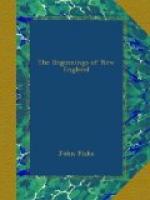This liberal grant was made at a time when people still supposed the Pacific coast to be not far west of Henry Hudson’s river. The territory was granted to an association of six gentlemen, only one of whom—John Endicott—figures conspicuously in the history of New England. The grant was made in the usual reckless style, and conflicted with various patents which had been issued before. In 1622 Gorges and John Mason had obtained a grant of all the land between the rivers Kennebec and Merrimack, and the new grant encroached somewhat upon this. The difficulty seems to have been temporarily adjusted by some sort of compromise which restricted the new grant to the Merrimack, for in 1629 we find Mason’s title confirmed to the region between that river and the Piscataqua, while later on Gorges appears as proprietor of the territory between the Piscataqua and the Kennebec. A more serious difficulty was the claim of Robert Gorges, son of Sir Ferdinando. That young man had in 1623 obtained a grant of some 300 square miles in Massachusetts, and had gone to look after it, but had soon returned discouraged to England and shortly afterward died. But his claim devolved upon his surviving brother, John Gorges, and Sir Ferdinando, in consenting to the grant to Endicott and his friends, expressly reserved the rights of his sons. No such reservation, however, was mentioned in the Massachusetts charter, and the colonists never paid the slightest heed to it. In these conflicting claims were sown seeds of trouble which bore fruit for more than half a century. In such cases actual possession is apt to make nine points in the law, and accordingly Endicott was sent over, as soon as possible, with sixty persons, to reinforce the party at Naumkeag and supersede Conant as its leader. On Endicott’s arrival in September, 1628, the settlers were at first inclined to dispute his authority, but they were soon conciliated, and in token of this amicable adjustment the place was called by the Hebrew name of Salem, or “peace.” [Sidenote: Conflicting grants sow seeds of trouble] [Sidenote: John Endicot and the founding of Salem]




